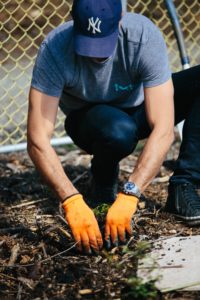
Kiwis are being challenged to get behind Arbor Day on Monday 5 June, 2017 and be part of a record-setting attempt: to plant the largest number of native trees in New Zealand in one day.
The challenge comes from Trees That Count, an ambitious, recently launched conservation movement that aims to inspire New Zealanders to plant 4.7 million native trees in 2017 – that’s one tree planted for every person. The Arbor Day campaign provides an opportunity for everyone to make a substantial impact, says Trees That Count’s project director Tanya Hart.
“We’re aiming to get more than 10,000 trees pledged and planted for Arbor Day, which also happens to be a public holiday,” Tanya explains. “With almost 9,000 trees pledged so far, we’re well on the way to success, but we’d love for more Kiwis to get their hands dirty. There’s never been a record set for this before, and we want to set the bar high so we can do even better next year.”
“Planting native trees helps restore and enhance New Zealand’s environment, by creating habitats for native birds and insects, and encouraging clean air and waterways. Crucially, it also makes a difference to climate health in New Zealand by reducing our greenhouse gas emissions,” adds Tanya.
“If every Kiwi plants just one native tree, whether at a community planting event or in their back garden, this small action will have a major effect against climate change.”
The Trees That Count website (www.treesthatcount.co.nz) features a live counting tally of planting activity that will enable everyone to keep up with the Arbor Day tally, and progress towards the 2017 goal of 4.7 million trees planted.
Celebrated by countries worldwide, Arbor Day is about inspiring people to plant and nurture trees. New Zealand’s first Arbor Day planting was on 3 July 1890 at Greytown, in the Wairarapa, where children from Greytown School, residents and dignitaries planted 153 trees at the
southern end of the town. More than 125 years later, the day holds even greater significance as climate change becomes an ever-pressing concern.
Using Ministry for Primary Industries figures, researcher Dr David Hall has estimated that if 40 native trees were planted for every New Zealander it would be roughly enough to negate New Zealand’s average annual increase in greenhouse gas emissions since 1990. Recording the number of native trees planted each year is a vital first step.
Since 1977, New Zealand has celebrated Arbor Day on 5 June. Some environmental organisations continue to plant trees on Arbor Day, but Trees That Count wants to firmly embed the day back into the national consciousness. Many people may remember getting a day off school to plant trees as children – and also remember where that tree is now, having seen it grow, and feel a sense of pride from their planting efforts.
Celebrities and notable Kiwis such as Eliza McCartney, Ruud Kleinpaste, Grant Dalton and Josh Emett have also pledged their support to the programme.
Sir Stephen Tindall, co-founder of The Tindall Foundation (which funds Trees That Count), encourages people to get involved. “Planting native trees in your neighbourhood, on your farm, at school or outside your office is one of the best things you can do for the local environment and for the planet. It is also a great way to bring people together and connect with your local community.”
“Trees That Count is making progress, but we think we can do better and we need your help!”
Pledge to plant a tree and register it on the Arbor Day campaign page, or support the campaign by donating a tree (for $10) that will be planted on your behalf. The website also contains useful information about the types of trees to plant, and planting tips.
*A note to planting groups regarding myrtle rust.
Myrtle rust can have serious consequences for various species of plants in the myrtle family, including New Zealand native plants such as: pōhutukawa, ramarama, rata, rōhutu, mānuka, swamp maire, kānuka. Introduced plants including, feijoa, eucalypts and bottle brushes are also susceptible to myrtle rust
DOC is working closely with MPI trying to restrict the spread of the disease. DOC staff are actively looking out for potentially infected plants in the wild. The impact on native forests will be noticeable if myrtle rust becomes established.
For groups located in Northland, Taranaki and Waikato regions, Myrtaceous plants should not be planted at any planting days coming up, unless the disease is declared to be eradicated before the proposed planting date. For all other plant species, it is advisable to ensure the nursery of origin has been adhering to the NZPPI hygiene protocols and you keep a record of number of plants by species, their origin and planting location, as these plants can still be a vector.
For all other regions, planting of Myrtaceous species may proceed if plants are not sourced from Northland, Waikato or Taranaki. Ensure the nursery of origin has been adhering to the NZPPI hygiene protocols and keep a record of number of plants by species, their origin and planting location.









